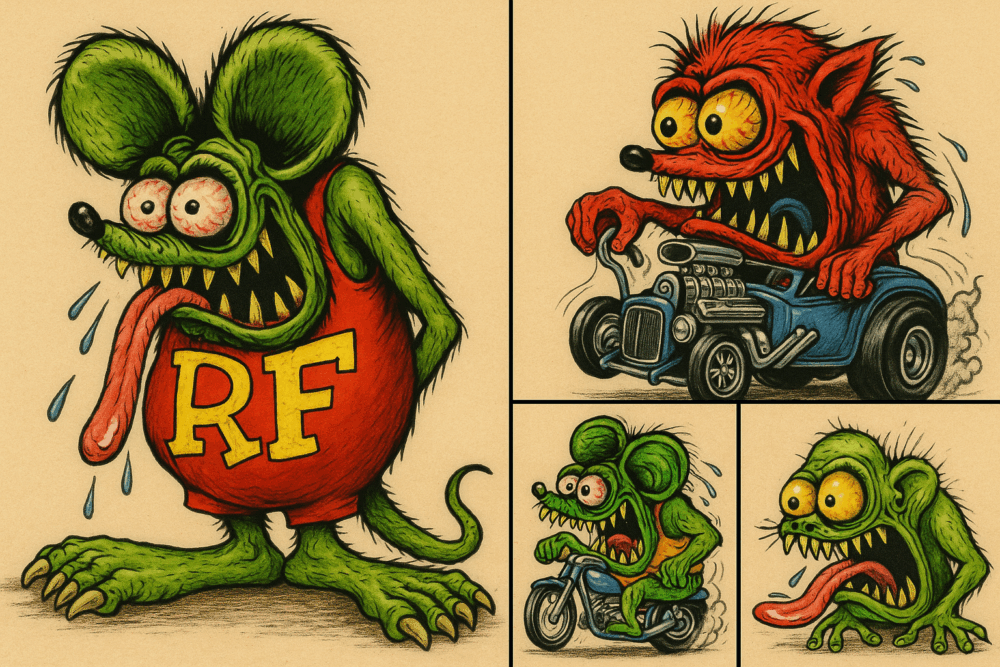Ed “Big Daddy” Roth wasn’t just an artist or car builder — he was a cultural force. Born in 1932 in Beverly Hills, California, Roth exploded onto the 1950s and ’60s American custom car scene with a wild, rebellious style that captured the imagination of a generation. His grotesque cartoon characters, outrageous custom cars, and unrelenting creativity helped define the look and feel of hot rod and custom car culture for decades.
The Birth of a Hot Rod Icon
Growing up during the post-Depression era, Roth took a liking to building model airplanes and working with his hands. After serving in the Air Force, he attended trade school and began pinstriping and customizing cars — but not in the traditional sense. Roth was different. Where others stuck to chrome, flames, and conventional lines, Roth brought monsters, madness, and fiberglass into the garage.
By the late 1950s, he had earned the nickname “Big Daddy,” and with it came a brand that would eventually revolutionize the custom car world.
Rat Fink and the Rise of Kustom Kulture
Roth’s most famous creation wasn’t a car — it was a character. Rat Fink, a grotesque, bug-eyed, green monster with sharp teeth and a distended belly, was the anti-Mickey Mouse. Born from Roth’s countercultural leanings, Rat Fink became the mascot of “Kustom Kulture,” a 1960s movement blending custom cars, hot rods, rock ’n’ roll, surf music, and lowbrow art.
Roth’s artwork — silk-screened on T-shirts and sold at car shows and through magazines like Car Craft — made him a household name among car-crazy teens. His illustrations featured souped-up hot rods piloted by monster drivers, all exaggerated and brimming with chaotic energy.
The Cars That Bent Reality
Roth wasn’t just an artist — he was a visionary builder. He experimented with fiberglass when few others dared, creating cars that looked more like science fiction spacecraft than street rods. Some of his legendary builds include:
- The Outlaw (1959) – A radical fiberglass roadster that broke every rule in traditional hot rod design.
- Beatnik Bandit (1961) – Perhaps his most famous car, controlled by a joystick instead of a steering wheel.
- Mysterion (1963) – A twin-engine dream machine that looked like it came from another planet.
- Orbitron (1964) – Lost for decades, this psychedelic car with a television in the front was eventually found and restored.
Each build was a rolling work of art, showing off Roth’s knack for blending mechanics, style, and pop culture fantasy.
Beyond the Garage
Roth’s impact extended well beyond the custom car scene. He influenced graphic artists, tattoo culture, comic book style, and punk aesthetics. His work helped pioneer what would later be called “lowbrow art,” a movement that found gallery respect decades after its garage-born beginnings.
Though Roth’s popularity waned in the 1970s, a new generation of artists and enthusiasts rediscovered his work in the 1990s. Before his death in 2001, he saw a major revival of interest in his creations and was celebrated at hot rod shows and art galleries alike.
Legacy and Lasting Impact
Today, Ed “Big Daddy” Roth is considered one of the most important figures in American pop culture design. His vision laid the groundwork for an entire aesthetic: loud, weird, rebellious, and unapologetically bold. From garage kits to gallery shows, his work continues to inspire builders, artists, and misfits alike.
More than a car guy or cartoonist, Roth was a true American original — a hot rod hero with a spray gun in one hand and a monster in the other.

